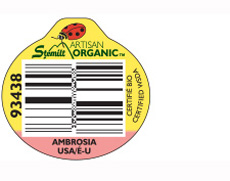PRODUCT: Ambrosia Apples
|
THE ORCHARD OF EDEN No one is sure about which apple variety Eve might have plucked from the tree of knowledge, causing all hell to break loose. In the millennia gone by though, the rest of us have gone from fig leaf to overalls trying to re-create the paradigm of that luscious, lascivious fruit. Leave it to a maverick bee. Rather than head for the usual haunts, this one took a tour of British Columbia, picking up some pollen from this apple blossom and leaving it on that apple blossom en route. One day, a lucky apple grower noticed a stranger in his orchard: an apple that didn’t look like the others. Without so much as a snake to tempt him, he bit. Ahhh. Ambrosia! Indeed, Ambrosia is the recently coveted variety of apple that Washington State apple growers have been perfecting for several years, and now it’s freshly harvested and making its way to markets far and wide, including yours. What has made Ambrosia sprint to the top 10 varieties of apple sold in 2015? It has everything going for it: |

TOP PHOTO: Like the Garden of Eden: a tree brimming with Ambrosia apples. Photo courtesy AmbrosiaApples.com. BOTTOM PHOTO: After picking, apples are sorted and get a bath prior to packing and shipping. Photo by Rowann Gilman | THE NIBBLE. |
|
|
From root stock to loading dock, every apple is hand-picked, graded, sorted and even x-rayed for imperfections so that each one that reaches you is Garden of Eden-worthy. The process takes an entire year, after which the fruit is cold-stored for shipping to markets from September through July. Ambrosia are harvested with an ideal sugar/starch balance in mind rather than color as other apples are, and because of that you can always spot Ambrosia in a crowd: The pretty patterns arrayed around their stems and cheeks are creamy yellow where leaves have shaded them from the sun. GENERAL TIP: Select apples that have stems intact. The stem acts as a “cork,” making sure moisture and flavor do not dissipate. To become an Ambrosian, just look for the label in the photo below. Discover more at MySweetAmbrosia.com. —Rowann Gilman |
||

|
THE HISTORY OF APPLES Apples seem like the universal European fruit. But they first grew wild in the Tien Shan mountains of Kazakhstan, in Central Asia, millions of years ago. Those early apples were likely smaller and more sour than modern apples—more like crabapples. By about 6500 B.C.E., travelers were carrying cultivated apple seeds west, to West Asia, and east to China. Charred remains of apples have been found at a Stone Age village in Switzerland. (The Stone Aged spanned 6000 B.C.E to 2000 B.C.E.) [Source] The Greeks grew several varieties of apples by the third century B.C.E.; the ancient Romans also grew and loved the fruit. Around 100 C.E., the Roman Legions brought apples with them as they advanced north through Europe. Gaul (ancient France) became a fertile region for apple cultivation. Brittania (England) also grew the Roman-brought apples. Centuries later, following the Norman conquest in 1066, new varieties of apple from France were introduced to England. Apples were a boon to Europeans. They ripened just as it was getting cold and they could keep all winter, a valuable food source when nothing else was growing. Apples were also sliced, dried and stored. And bitter varieties were pressed to make cider. Apples arrived in the New World in 1607, with the Jamestown settlers. The seeds and cuttings they brought from Europe were not all suited for cultivation in Virginia, but they began to mutate to new varieties of American apples. Many of these apples were fairly bitter—not hand fruit, but important for making cider, which was more valuable than hand fruit or cooking fruit. |
|
|
Most colonists grew their own apples. Due to unhealthy water supplies, most people, including children, drank beer or hard cider instead of water (the same was true in Europe). Apples were being grown in Massachusetts as early as 1630. Mutation was continually creating new breeds. The McIntosh mutation was discovered in 1796 (by a farmer named John McIntosh). Sweet apples for eating were grown as well (and today they’re grown in every state). Thomas Jefferson had a part in the development of the Fuji apple. As the story goes, the French minister to the United States gave Jefferson a gift of apple cuttings; Jefferson donated them to a Virginia nursery which cultivated them as the “Ralls Genet.” In 1939, Japanese apple breeders crossed the genes from the Red Delicious apple with the Ralls Genet, resulting in the now-ubiquitous Fuji apple. [Source]
|
||

